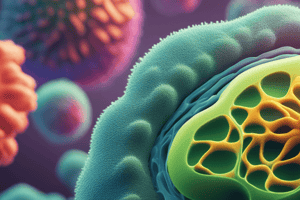Podcast
Questions and Answers
What distinguishes eukaryotic cells from prokaryotic cells?
What distinguishes eukaryotic cells from prokaryotic cells?
- Presence of a nucleus and membrane-bound organelles (correct)
- Presence of a cell wall
- Size of the cell
- Absence of a nucleus
What is the function of vacuoles in animal cells?
What is the function of vacuoles in animal cells?
- Facilitate photosynthesis
- Remove waste products (correct)
- Store water
- Provide structural support
What are plant cell walls primarily comprised of?
What are plant cell walls primarily comprised of?
- Proteins and lipids
- Cellulose and other polysaccharides (correct)
- Nucleic acids
- Starch and sugars
What is the function of plant vacuoles?
What is the function of plant vacuoles?
What is turgor pressure in plants primarily responsible for?
What is turgor pressure in plants primarily responsible for?
What are the differences between plant and animal vacuoles?
What are the differences between plant and animal vacuoles?
What distinguishes plant cells from animal cells?
What distinguishes plant cells from animal cells?
What primarily fills the central vacuole in plant cells?
What primarily fills the central vacuole in plant cells?
What is the main function of the plant cell wall?
What is the main function of the plant cell wall?
What is the role of the tonoplast membrane in the central vacuole?
What is the role of the tonoplast membrane in the central vacuole?
What maintains plant cell shape and regulates water content?
What maintains plant cell shape and regulates water content?
In what type of solution does a plant cell lose water and wilt?
In what type of solution does a plant cell lose water and wilt?
What is the primary role of animal vacuoles?
What is the primary role of animal vacuoles?
What happens to turgor pressure in a plant cell in an isotonic environment?
What happens to turgor pressure in a plant cell in an isotonic environment?
What maintains the shape of a plant cell and protects against pathogens and insects?
What maintains the shape of a plant cell and protects against pathogens and insects?
Flashcards are hidden until you start studying
Study Notes
Plant Cell Vacuoles and Cell Wall Structure
- Plant cells can have a single large central vacuole or several smaller vacuoles, while animal cells have smaller lysosome-type vacuoles involved in waste endocytosis.
- Central vacuoles in plant cells can make up to 90% of the cell's inner space and are filled primarily with water.
- The central vacuole structure includes a tonoplast membrane that regulates water flow and contains cell sap with water, enzymes, and ions.
- The central vacuole's primary role is to maintain turgor pressure, store water, nutrients, and waste, and regulate cellular pH.
- The plant cell wall, made of cellulose, provides strength and flexibility and works with vacuoles to maintain turgor pressure.
- The cell wall has three layers: primary cell wall, secondary cell wall, and middle lamella, each with distinct compositions and functions.
- Cellulose in the cell wall maintains plant cell shape, regulates water content, facilitates communication between cells, and protects against pathogens and insects.
- The cell wall and central vacuole work together through osmosis to maintain turgor pressure and plant cell shape.
- In a hypotonic environment, the central vacuole maintains turgor pressure, while in an isotonic environment, turgor pressure is absent, resulting in a soft cell. In a hypertonic solution, the plant cell loses water and wilts.
- Animal vacuoles are involved in the immune response to pathogens, where they engulf foreign particles and fuse with lysosomes to destroy potential pathogens.
- The plant cell wall, made of cellulose, provides strength and flexibility and works with vacuoles to maintain turgor pressure.
- The cell wall has three layers: primary cell wall, secondary cell wall, and middle lamella, each with distinct compositions and functions.
Studying That Suits You
Use AI to generate personalized quizzes and flashcards to suit your learning preferences.




